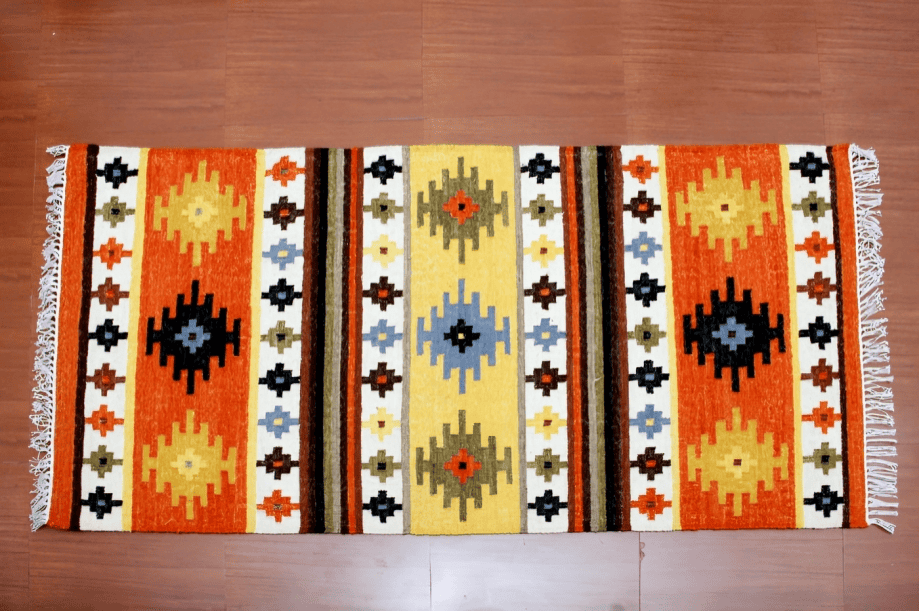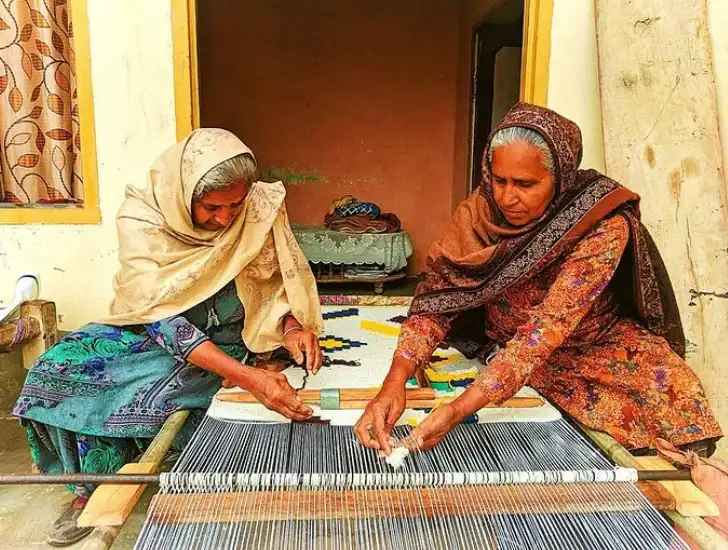Woven with pride and purpose, India’s dhurries reflect timeless craftsmanship and cultural identity, yet face a fading presence in today’s fast-changing world.

A handwoven rug or a thin flat carpet is an example of an item of home furnishings that is referred to as a dhurrie in India. This word may also be spelt dhurri, durrie, durry, or dari. The dhurries each have a one-of-a-kind design that is derived from the nation from which they originated, such as multicoloured stripes, which are one of the most common patterns. Weaving a dhurrie was a significant economic activity in rural areas of India. Dhurrie are historically used in South Asian cultures as a kind of floor covering.
Weaving dhurrie has developed into one of the most prosperous traditions in India and is an important part of the lives of many people who live in rural areas. The custom has been handed down from generation to generation, and it carries with it an extensive decorative lexicon of cultural meaning. Patterns have been passed down through generations, both to transfer a set of skills and as a type of dowry.
History
Weaving dhurries is an ancient skill that extends back hundreds of years. Dhurrie is a traditional garments from India and the nations that border it, including Burma, Pakistan, and Afghanistan. Traditional uses for dhurries include serving as floor mats, bed coverings, wall hangings, and yoga and meditation mats.
Dhurrie were also used to cover mattresses. Dhurrie may be made from a wide range of materials, each of which lends the finished product distinct hardiness, pliability, and feel. While some are velvety to the touch and toasty to the touch, others are smooth and icy to the touch. Wool, silk, and cotton are three of the most commonly used materials for handwoven dhurries. Other materials that are sometimes used include bamboo silk, banana leaf, cashmere, wool, and alpaca.

Weaving dhurries has developed into one of India’s many cherished traditions, which not only exemplifies the spirit of India but also enables a great number of villages to earn a living. Weavers are responsible for keeping this age-old skill alive thanks to their deft handiwork, which has been handed down from one generation to the next. In addition, conventional patterns and methods have been handed down from generation to generation.
Process
Weaving a dhurrie requires the use of a looming machine to complete the process. Even it comes to operating the loom, various methods are used in different parts of the world. The most frequent techniques of weaving dhurries include the use of pit looms, which require the weaver to move the loom with their feet, and panja dhurries, which are manufactured with the use of a “panja,” which is a claw-like instrument used to thread the wefts of yarn, and other types of handlooms. Historically, the most prevalent colours used to manufacture dhurries were classic tones like fiery orange, indigo, crimson, and green. Red was another traditional colour.
The weavers’ vivid sarees, turbans, and other traditional garb inspired the colours they used to reflect their own culture in their textiles. Weavers’ colour palettes have evolved to include a wider variety of colours, including those that are more modern. The most prevalent types of patterns and designs are stripes and geometric patterns. Aside from it, other sources of design inspiration include the local structure, trees of life, emblems of war, and even birds and flowers. Certain patterns turn out to be difficult to execute, taking several days on average. The level of skill of a craftsperson is often measured by how complicated the weaver’s patterns are.
Manufacturing
Weaving is done on a variety of looms in Rajasthan, including pit looms, in which the weaver sits in a pit and uses their feet to do the weaving. The Punja Dhurries, in particular, have helped make Haryana renowned for its dhurries. Nearly every hamlet has at least one dhurry, and the ladies of these communities participate in it as a kind of recreation. They are bright in appearance and may be used either as bedsheets or as floor coverings.
The dhurries that are produced in Haryana are among the most well-known textiles in all of India. Dhurries from Madhya Pradesh are famous for the vibrant colours and durable nature of their products. Dhurries are handcrafted in a variety of styles throughout the states of Rajasthan, Uttar Pradesh, Punjab, and Himachal Pradesh. When a girl is married in some of these states, the dhurries that are provided as part of the dowry are considered to be an essential component. In India’s Karnataka state, the Navalgund taluk is another important centre for the production of dhurries. In the native Kannada language, dhurries from Navalgund are referred to as jamkhana. This region has its geographical designation for dhurrie.
Uses
It all depends on the size, the design, and the material. They may be used for several things. The smallest one is the one that is used as a table cover for things like flower pots and telephone stands. They are also crafted in dimensions that are suitable for sitting in the position known as an aasan while practising meditation. Huge political or social events usually make use of dhurries. Due to their small weight and ability to be folded, dhurries are quite portable.
They are available in a wide range of colour combinations and designs, making them suitable for a wide range of occasions and tastes. Because they are not susceptible to infestation by silverfish or any of the other insects that are responsible for the destruction of carpets, dhurries have a minimal cost of upkeep. All seasons are appropriate for wearing dhurries. Cotton dhurries are perfect for keeping you warm during the winter and cool during the summer.
Where to buy: Cotton dhurries are produced throughout India, from Darjeeling to Gujarat and Chennai, and each location incorporates its unique local colours and geometrical designs into the dhurries that they produce. It can be purchased at retail establishments such as Rug Weave and Jaipur Rugs.
Read More: Latest



